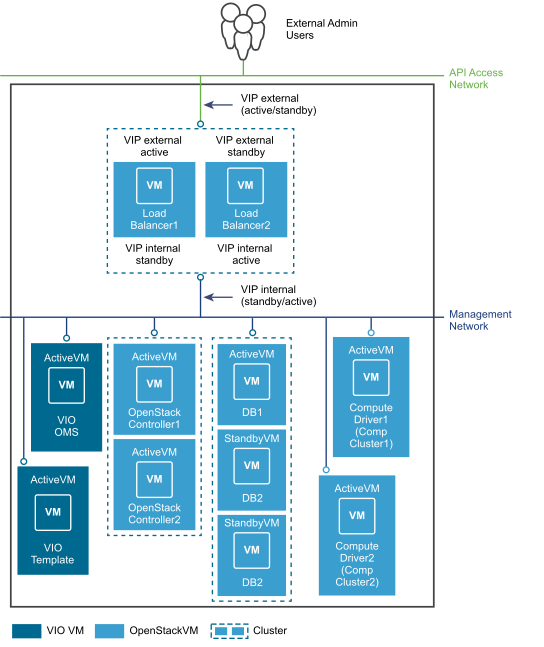An VMware Integrated OpenStack NSX deployment includes management and compute clusters with four principal networks. You can also separate the NSX Edge node into a separate cluster.
Cluster and Component Architecture
When you deploy VMware Integrated OpenStack using NSX, you can use two different deployment modes:
- Compact Mode - Consists of a single ESXi host running two VMs and using a minimum of 120 GB of storage.
- HA Mode - Consists of 8 or more VMs using a minimum of 552 GB of storage.

The VMware Integrated OpenStack architecture includes the following clusters and components.
| Cluster or Component | Description |
|---|---|
| vCenter Server instance | A dedicated vCenter Server instance is not required but optimizes deployment. |
| Active Directory | For user authentication by the OpenStack Identity Service. |
| Management cluster | Contains all the deployed OpenStack component and management VMs. See Management Cluster below for a detailed description of the management cluster and its components. |
| Compute cluster | Compute resources for Nova. All tenant VMs are created on these compute clusters. |
| NSX Edge cluster | Contains Edge VMs that provide edge security and gateway services to logical networks, and provide DHCP, Floating IP (NAT), Security Groups and routing functions for the OpenStack Networking component. |
| NSX Manager | The centralized network management component of NSX that provides an aggregated system view. |
| NSX Controllers | An advanced distributed state management system that controls virtual networks and overlay transport tunnels. |
| Management network | Carries traffic among the management components. |
| API access network | Exposes the VMware Integrated OpenStack dashboard and provides access for tenants to the OpenStack APIs and services. |
| Transport network | Connects the DHCP nodes in the Edge cluster with the compute clusters. |
| External Network | Provides external access for the VMware Integrated OpenStack deployments. |
The NSX Controller and NSX Manager nodes can be deployed on separate clusters or hosts. It is a best practice to deploy the NSX Controller and NSX Manager nodes in the Management Cluster.
Management Cluster

The management cluster contains the following components.
| Component | Description | Nodes |
|---|---|---|
| Load Balancers | Provide HA and enable horizontal scale-out architecture. |
2 (1 active, 1 standby) |
| Databases (DBs) | Instances of MariaDB that store the OpenStack metadata. RabbitMQ, the message queue service used by all OpenStack services, also runs on the database nodes. |
3 (1 active, 2 standby) |
| VMware Integrated OpenStack Controller | Contains all the OpenStack services, including Compute, Block Storage, Image Service, Identity Service, and Object Storage. The memcache service, which enables production-grade performance for the Identity Service, also runs on the controller nodes. |
2 (both active) |
| Compute Driver | Contains a subset of Compute processes that interact with the compute clusters to manage VMs. |
1 per compute cluster |
| VMware Integrated OpenStack Manager Service (OMS) | The vApp that you use to manage your VMware Integrated OpenStack vApp. |
1 |
| VMware Integrated OpenStack Template | Base template for creating all OpenStack service VMs. |
1 |
| Ceilometer Databases (optional) | Instances of MongoDB or NoSQL databases for use by Ceilometer. |
3 (1 active, 2 standby) |